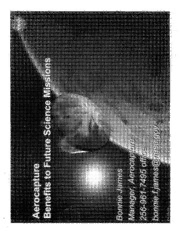
NASA Technical Reports Server (NTRS) 20070002619: Aerocapture Benefits to Future Science Missions PDF
Preview NASA Technical Reports Server (NTRS) 20070002619: Aerocapture Benefits to Future Science Missions
Source of Acquisition NASA Marshall Space Flight Center ~~~S Gwen Artis Bonnie James NASA’s In-Space Propulsion Technology (ISPT) Program is investing in technologies to revolutionize the robotic exploration of deep space. One of these technologies is Aerocapture, the most promising of the “aeroassist~t’e chniques used to maneuver a space vehicle within an atmosphere, using aerodynamic forces in lieu of propellant. (Other aeroassist techniques include aeroentry and aerobraking.) Aerocapture relies on drag atmospheric drag to decelerate an incoming spacecraft and capture it into orbit. This technique is very attractive since it permits spacecraft to be launched from Earth at higher velocities, providing shorter trip times and saving mass and overall cost on future missions. Recent aerocapture systems analysis studies quantify the benefits of aerocapture to future exploration. The 2002 Titan aerocapture study showed that using aerocapture at Titan instead of conventional propulsive capture results in over twice as much payload delivered to Titan. Aerocapture at Venus results in almost twice the payload delivered to Venus as with aerobraking, and over six times more mass delivered into orbit than all- propulsive capture. Aerocapture at Mars shows significant benefits as the payload sizes increase and as missions become more complex. Recent Neptune aerocapture studies show that aerocapture opens up entirely new classes of missions at Neptune. Current aerocapture technology development is advancing the maturity of each sub- system technology needed for successful implementation of aerocapture on future missions. Recent development has focused on both rigid aeroshell and inflatable aerocapture systems. Rigid aeroshell systems development includes new ablative and non-ablative thermal protection systems, advanced aeroshell performance sensors, lightweight structures and higher temperature adhesives. Inflatable systems such as trailing tethered and clamped “ballutes” and inflatable aeroshells are also under development. Computational tools required to support future aerocapture missions are an integral part of aerocapture development. Tools include engineering reference atmosphere models, guidance and navigation algorithms, aerothermodynamic modeling, and flight simulation. 'D m m I= .I a W 0 2 - .- m I > e I- m m t N 0 I ! ! I ! I I -A r -I- F % I- L 3 Q I 0 0 0 0 0 0 0 0 0 0 0 0 0 0 0 0 0 a3 b CD u3 Tf m cu r 7 0 rn + 3 c o E 8 a m c6" U M I S m cn \ E x r & > 0 rc 0 5 > 3 a, S m E
